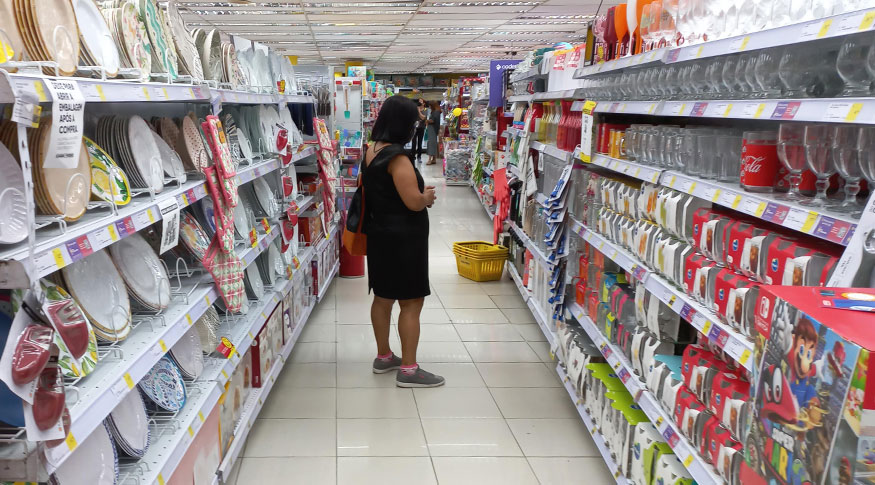Monthly Survey of Trade
Retail sales drop 3.1% in August, with more than half of the activities going down
October 06, 2021 09h00 AM | Last Updated: October 07, 2021 11h32 AM
Errata: The news reported that the drop in retail sales in August interrupted four months of highs. The information is incorrect, as the sector shrank 1.1% in June.

The retail sales volume in Brazil decreased 3.1% in August, compared to the previous month (2.7%). More than half of the activities fell in the period. In the year, retail accumulated a 5.1% high and in the last twelve months, growth of 5.0%. Data are from the Monthly Survey of Trade (PMC), released today (October 6) by the IBGE.
Six of the eight activities surveyed had negative rates in August, especially other articles of personal and domestic use (-16.0%), which had the main negative influence on the retail trade indicator. This activity is made up, for example, by large department stores.
“It was a sector that suffered a lot at the beginning of the pandemic, but it reinvented itself with the reformulation of its internet sales strategies. This culminated in significant growth, especially in July (19.1%) with the launch of marketplace platforms. Due to the many discounts, consumers anticipated their deals in July, causing the month of August to record a large drop of 16.0%. This retreat, however, is not enough to remove the gains from the previous four months”, explains PMC manager Mr. Cristiano Santos.
Other sectors also had decrease in the inter-annual indicator: office, computer and communication equipment and material (-4.7%), fuels and lubricants (-2.4%), furniture and household appliances (-1.3%), books, newspapers, magazines and stationery (-1.0%) and hypermarkets, supermarkets, food products, beverages and tobacco (-0.9%).
“Hyper and supermarkets, as well as fuels and lubricants, have been affected by inflation rise in recent months, which reduces the drive for consumption of families and companies. The nominal revenue of hyper and supermarkets was close to zero (0.3%) and that of fuels dropped 0.7%. There was actually a lower expenditure by families from July to August”, adds Mr. Santos.
The two activities that registered positive changes in the volume of sales in August were fabric, apparel and footwear (1.1%) and pharmaceutical and medical goods, cosmetic and toilet articles (0.2%).
In the extended retail trade, which includes motor vehicles, motorcycles, parts and pieces and construction material, the sales volume decreased 2.5% in August in relation to July. The activity of motor vehicles, motorcycles, parts and pieces had a positive change of 0.7%, while construction material had a negative change (-1.3%).
Retail has the first negative inter-annual rate since February
In one year, compared to August 2020, retail trade had a drop of 4.1%, after five consecutive positive rates. This result came from declines in the segments of furniture and household appliances (-19.8%), office, computer and communication equipment and material (-9.1%), hypermarkets, supermarkets, food products, beverages and tobacco (-4, 6%) and other articles of personal and domestic use (-1.7%).
On the other hand, four other activities had an increase in the inter-annual indicator: pharmaceutical and medical goods, cosmetic and toilet articles (6.5%), books, newspapers, magazines and stationery (1.3%), fabric, apparel and footwear (1.0%) and fuels and lubricants (0.4%).
The expanded retail trade was stable (0.0%), compared to August last year, registering an increase of 16.8% in the activity of motor vehicles and motorcycles, parts and pieces and a drop of 7.1% in the construction material sector .
“This is the first negative inter-annual rate since February The previous five positive rates reflected the very low basis of comparison at that time in 2020”, observes the manager. “Despite the retreat in August, retail is 2.2% above the pre-pandemic period. This level, however, is not the same among the sectors. There are activities that have not yet recovered their losses, such as office, computer and communication material ; fuels and lubricants and fabric; and wearing apparel and footwear,” he added.
Sales of the sector down in 24 Federation Units
The retail trade had negative results in 24 of the 27 Federation Units in August compared to the same month last year, with highlights to Rondônia (-19.7%), Paraná (-11.0%), Mato Grosso (-10, 9%), Acre (-10.2%) and Santa Catarina (10.1%). The three states that registered positive rates were Ceará (2.0%), Maranhão (1.0%) and Roraima (0.3%).
In extended retail trade, the negative change was followed by 20 of the 27 Federation Units, the main ones being Amapá (-9.2%), Paraná (-9.0%) and Rondônia (-7.4%). On the other hand, the main increases were registered by Pará (1.3%), Ceará (1.1%) and Sergipe (1.1%). Alagoas stood stable (0.0%).
More about the survey
The Monthly Survey of Trade - PMC - produces indicators to follow up the short-term behavior of the retail trade in Brazil, investigating the gross revenue in formal enterprises with 20 or more employed persons and whose major activity is retail trade.
Started in 1995, the PMC brings monthly results of changes in sales volume and nominal revenue for the retail trade and extended retail trade for Brazil and Federation Units. The data collection technique includes the self-filled electronic questionnaire (CASI) and personal interview with paper questionnaire (PAPI). Results can be accessed on Sidra.


















